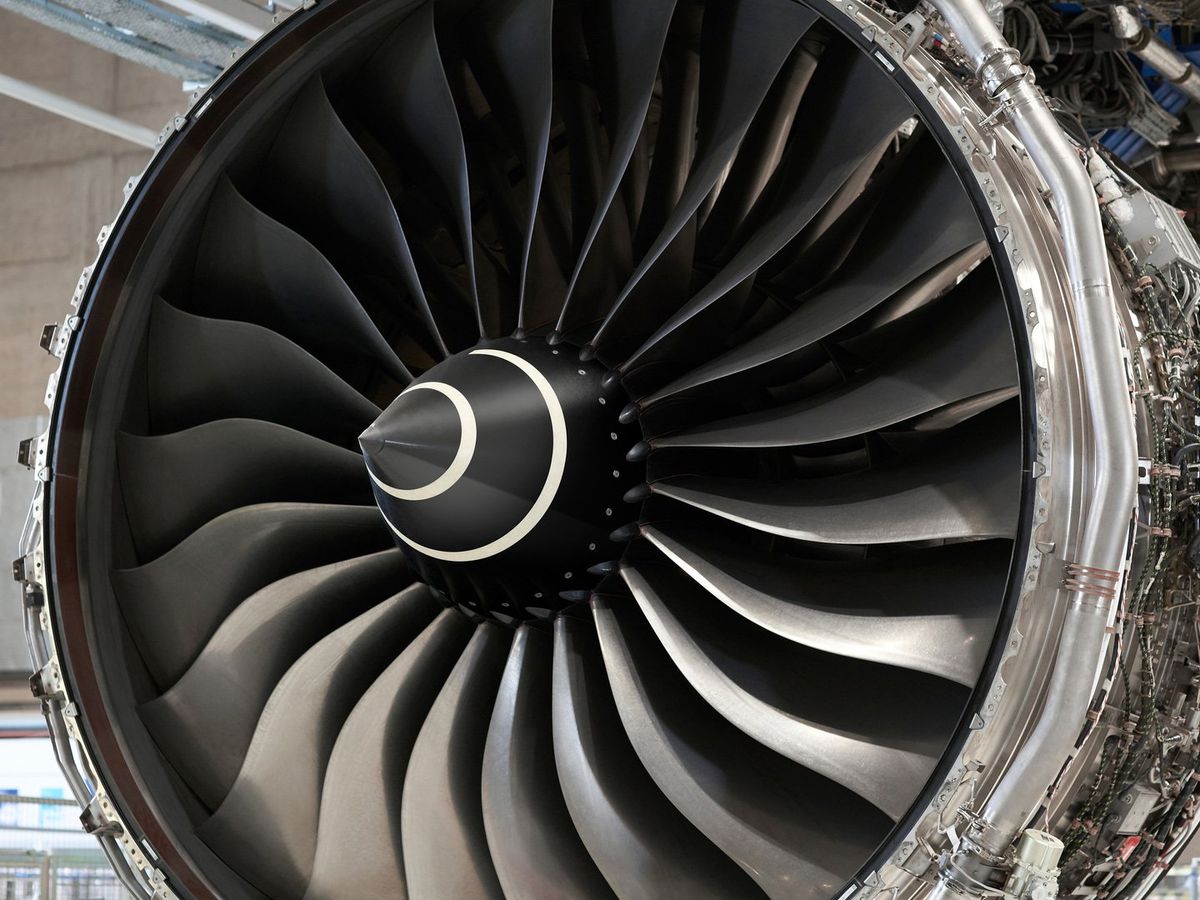Simulating how air and gases flow through a jet engine is one of the most challenging computing problems in engineering. Engineers at Rolls-Royce think quantum computers could give these calculations a significant boost. So they’ve collaborated with Nvidia to simulate the largest ever quantum circuit for computational fluid dynamics (CFD).
With scores of fan blades spinning at thousands of rotations a second, and airflows measuring in hundreds of kilometers per hour, modeling the inner workings of a jet turbine is incredibly complex. But it’s also critical for designing more powerful and efficient engines, something that’s becoming increasingly important as the aviation industry attempts to reduce its climate impact.
Rolls-Royce already makes wide use of CFD simulations in its design processes, but the enormous computational resources required means its engineers typically have to compromise on fidelity or scale. Quantum computers could provide the speedup needed, though, says Leigh Lapworth, a fellow in computational science at Rolls-Royce.
“This is opening up a large new area for quantum computing, and for industries that thought quantum computing had nothing for them.”
—Frank Gaitan, University of Maryland
Today’s quantum processors are still too small to simulate complex systems like jet engines. But Lapworth says that Rolls-Royce still sees value in developing quantum algorithms for CFD, which is why it has teamed up with Nvidia and Israeli quantum-software company Classiq. Last month, the companies announced that they had used Nvidia’s GPU-based quantum simulator to test a 39-qubit quantum CFD circuit with a depth of 10 million layers. That’s the largest such simulation to date, and it “unlocks the next step of our research agenda,” says Lapworth.
“We know from previous experience, getting these applications to a production-ready standard takes just as long as the hardware development,” he says. “We need to do the algorithms development and the application development, such that when those devices appear, we’ve got the applications ready to go.”
Simulating quantum circuits involves using classical computers to model all of the quantum interactions that would happen inside a quantum processor. The number of required calculations scales exponentially with the number of qubits, however, so it’s not surprising that a classical computer simulation of a quantum computer can achieve meaningful results only at smaller size scales.
Yet, the insights this smaller-size simulation can still provide, says Lapworth, are proving valuable in further designing and optimizing the quantum algorithm.
How does quantum CFD work?
Rolls-Royce’s approach to quantum CFD simulation is based on the HHL algorithm, which can solve linear algebra problems exponentially faster than classical approaches can, given enough qubits. CFD systems use both linear and nonlinear algebra, so the solution is actually a hybrid scheme that leaves the nonlinear parts of the problem to classical hardware.
In theory, the approach should lead to significant speedups on future quantum computers. But the only way to make sure that the algorithm works is to run it and compare the results to those produced by a classical CFD simulator, something not possible with today’s rudimentary quantum hardware. “There’s no quantum computer on the planet that could run that circuit today,” says Lapworth.
Simulating these kinds of quantum algorithms on classical hardware can certainly be tricky, says Lapworth. While they can solve massive computational challenges that are intractable for classical computers, quantum computers’ complexity means that on smaller problems they may also run significantly slower, he says. That’s where Nvidia comes in. By using Nvidia’s A100 GPUs to accelerate their simulations, the team has now managed to run the circuit at a scale large enough to perform meaningful comparisons against experimental data of the jet engines and their components at work, says Lapworth.
The approach Rolls-Royce has taken makes sense, says Frank Gaitan, a research physicist at the University of Maryland, because it uses a similar strategy to existing CFD simulation algorithms. It just involves swapping out a classical linear equation solver for a quantum one. But he points out that the HHL algorithm does have limitations, because unless the input meets some fairly stringent constraints, the exponential speedup can be lost. His group has devised a different quantum algorithm for CFD that only achieves a quadratic speedup and only works on problems that feature turbulence, but it can deal with both linear and nonlinear calculations and is considerably simpler, he says.
Nonetheless, he thinks the research shows people are recognizing that quantum computers could have far more applications than originally assumed. “Prior to some of this work, I think most people thought quantum computers were for factoring integers, searching databases, that sort of stuff,” he says. “This is opening up a large new area for quantum computing, and for industries that thought quantum computing had nothing for them.”
Rolls-Royce isn’t the only company intrigued by quantum computing’s potential for CFD applications. A spokesman for Pennsylvania-based simulation-software provider Ansys, said the company is working on quantum approaches for speeding up both CFD and other physics simulations. And David Heiny, CEO of German provider SimScale, also says the technology is on their radar. “Quantum approaches to CFD and simulation in general are something SimScale is interested in and keeping an eye on,” he says.
- Nvidia's Supercomputing CPU Puts Intel Under Pressure ›
- AI System Beats Supercomputer in Combustion Simulation ›
- How Researchers Use Nvidia's GPUs To Simulate Qubits - IEEE Spectrum ›
Edd Gent is a freelance science and technology writer based in Bengaluru, India. His writing focuses on emerging technologies across computing, engineering, energy and bioscience. He's on Twitter at @EddytheGent and email at edd dot gent at outlook dot com. His PGP fingerprint is ABB8 6BB3 3E69 C4A7 EC91 611B 5C12 193D 5DFC C01B. His public key is here. DM for Signal info.



